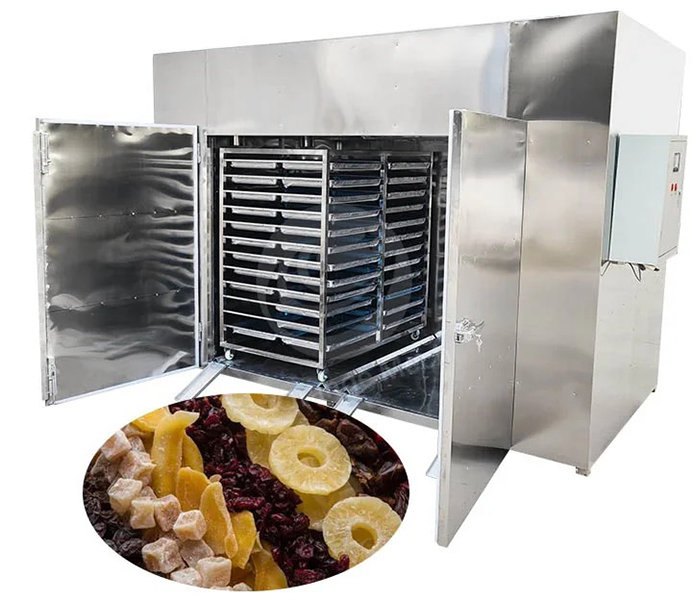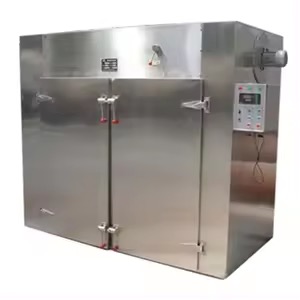
Content Menu
● Understanding Food Dehydration
>> How Does a Food Dehydrator Work?
● Benefits of Using Heat Pump Dryers
● Key Features of Cheap Heat Pump Condenser Dryers
>> 1. Temperature Range
>> 2. Moisture Control
>> 3. Build Quality
>> 4. User-Friendly Controls
● Considerations When Choosing a Cheap Heat Pump Dryer
● Comparing Heat Pump Dryers with Other Drying Methods
● Practical Applications of Heat Pump Dryers
● Maintenance Tips for Optimal Performance
● Conclusion
● FAQs
>> 1. What types of foods can be dried using heat pump dryers?
>> 2. How long does it take to dehydrate food using a heat pump dryer?
>> 3. Are heat pump dryers energy efficient?
>> 4. Can I control the temperature and humidity in a heat pump dryer?
>> 5. What maintenance does a heat pump dryer require?
● Citations:
In the realm of food processing and preservation, food dehydrators play a crucial role in extending the shelf life of various products while maintaining their nutritional value. As a manufacturer of food drying machines, understanding the reliability and efficiency of different drying technologies, particularly cheap heat pump condenser dryers, is essential for both producers and consumers. This article explores the workings, benefits, and considerations of using heat pump dryers in food dehydration.

Understanding Food Dehydration
Food dehydration is a method that removes moisture from food items to inhibit the growth of bacteria, yeasts, and molds. This process helps in preserving the flavor, color, and nutritional value of food. Dehydrators typically consist of trays for holding food, heating elements to raise the temperature, and fans to circulate hot air evenly throughout the machine.
How Does a Food Dehydrator Work?
1. Heating Elements: The dehydrator's heating element raises the temperature inside the machine.
2. Air Circulation: A fan circulates hot air over the food, ensuring even drying.
3. Moisture Removal: As heat is applied, moisture evaporates from the food. The moist air is expelled through vents to maintain a dry environment inside the dehydrator.
4. Temperature Control: Most modern dehydrators come with adjustable temperature settings tailored for different types of food.
This process allows for effective moisture removal without compromising on taste or nutrients.
Benefits of Using Heat Pump Dryers
Heat pump dryers have gained popularity due to their energy efficiency and effectiveness in preserving food quality. Here are some notable advantages:
- Energy Efficiency: Heat pump technology utilizes low-temperature heat from the environment, significantly reducing energy consumption compared to traditional dryers.
- Nutrient Retention: By operating at lower temperatures, heat pump dryers help retain essential vitamins and minerals that might be lost in higher-temperature drying methods.
- Cost-Effectiveness: Although initial costs may be higher, the long-term savings on energy bills make heat pump dryers a financially sound investment.
- Versatility: These dryers can handle a wide range of products including fruits, vegetables, meats, and herbs.
- Environmentally Friendly: Heat pump dryers produce less waste and consume less energy than conventional methods.
Key Features of Cheap Heat Pump Condenser Dryers
When considering cheap heat pump condenser dryers for food dehydration, several features should be evaluated:
1. Temperature Range
Cheap heat pump dryers typically operate within a temperature range of 20°C to 80°C. This flexibility allows users to dehydrate various foods effectively while preserving their quality.
2. Moisture Control
Effective moisture control systems are crucial for ensuring that food is dried uniformly without reabsorbing moisture during the process.
3. Build Quality
While looking for cost-effective options, it's essential to ensure that the dryer is made with durable materials that can withstand continuous use without compromising performance.
4. User-Friendly Controls
Digital control panels that allow precise adjustments in temperature and humidity levels can enhance user experience and ensure optimal drying conditions.

Considerations When Choosing a Cheap Heat Pump Dryer
While there are numerous benefits to using cheap heat pump condenser dryers, there are also considerations to keep in mind:
- Initial Investment vs. Long-Term Savings: Although cheaper models may save money upfront, they might not offer the same longevity or efficiency as higher-end models.
- Maintenance Requirements: Regular maintenance is necessary to ensure optimal performance; some cheaper models may require more frequent servicing.
- Capacity Limitations: Assessing your production needs is vital; smaller units may not meet high-volume demands efficiently.
Comparing Heat Pump Dryers with Other Drying Methods
To better understand where cheap heat pump condenser dryers stand in terms of reliability and efficiency, it's beneficial to compare them with other common drying methods:
| Feature | Heat Pump Dryers | Conventional Dryers | Solar Dryers |
| Energy Efficiency | High | Moderate | Variable |
| Temperature Control | Excellent | Limited | Limited |
| Nutrient Retention | High | Moderate | Moderate |
| Initial Cost | Moderate | Low | Low |
| Operating Cost | Low | Moderate | Free (after setup) |
| Environmental Impact | Low | Moderate | Low |
From this comparison table, it's evident that while conventional and solar dryers may have lower initial costs or operational costs respectively, heat pump dryers excel in energy efficiency and nutrient retention—key factors for anyone serious about food preservation.
Practical Applications of Heat Pump Dryers
Heat pump dryers are versatile machines used across various industries for different applications:
- Fruit Dehydration: Fruits like apples, bananas, and mangoes can be dried into snacks or ingredients for cereals and granola bars. The low-temperature operation helps preserve their natural sweetness and color.
- Vegetable Dehydration: Vegetables such as tomatoes, carrots, and peppers can be dehydrated for soups or snacks. The process retains their flavor while allowing for long-term storage without refrigeration.
- Herbs and Spices: Fresh herbs like basil and oregano can be dried to create flavorful seasonings. Heat pump dryers maintain their aromatic properties better than traditional methods.
- Meat Processing: For making jerky or dried meats, heat pump dryers provide controlled conditions that inhibit bacterial growth while effectively removing moisture.
Maintenance Tips for Optimal Performance
To ensure your cheap heat pump dryer operates efficiently over time, consider these maintenance tips:
- Regular Cleaning: Clean filters and trays regularly to prevent buildup that could hinder airflow or affect drying efficiency.
- Check Seals: Ensure that door seals are intact to maintain internal temperature consistency; replace any worn seals promptly.
- Monitor Performance: Keep an eye on drying times; if they increase significantly without changes in load size or humidity levels, it may indicate a need for maintenance or repairs.
Conclusion
In conclusion, cheap heat pump condenser dryers can be reliable options for food dehydration when chosen wisely. They offer significant advantages in terms of energy efficiency, nutrient retention, and versatility. However, potential buyers should consider factors such as build quality, maintenance needs, and capacity before making a purchase decision.
Investing in a reliable heat pump dryer not only enhances food preservation capabilities but also contributes to sustainable practices in food processing. As consumers become more health-conscious and environmentally aware, the demand for efficient drying solutions will continue to grow.
By understanding how these machines work and what features to look for, manufacturers can make informed decisions that benefit both their operations and their customers' needs.

FAQs
1. What types of foods can be dried using heat pump dryers?
Heat pump dryers are versatile and can effectively dry fruits, vegetables, meats (like jerky), herbs, and even seafood.
2. How long does it take to dehydrate food using a heat pump dryer?
The drying time varies based on the type of food and thickness; generally, it takes between 4 to 8 hours for most items at appropriate temperatures.
3. Are heat pump dryers energy efficient?
Yes! Heat pump dryers are known for their energy efficiency compared to traditional drying methods due to their low-temperature operation and ability to recycle heat.
4. Can I control the temperature and humidity in a heat pump dryer?
Most modern heat pump dryers come with digital control systems that allow users to adjust both temperature and humidity settings for optimal drying conditions.
5. What maintenance does a heat pump dryer require?
Regular cleaning of filters and checking seals are essential maintenance tasks to ensure efficient operation; specific requirements may vary by model.
Citations:
[1] https://aradmachineryco.com/article/How-to-make-a-food-dehydrator
[2] https://pocketchangegourmet.com/how-does-a-dehydrator-work/
[3] https://etsolutions.in/10-amazing-benefits-of-electrical-food-dehydrator-machines/
[4] https://www.made-in-china.com/manufacturers/top-food-dehydrators.html
[5] https://www.youtube.com/watch?v=61kmLsq51VU
[6] https://www.alamy.com/stock-photo/food-dehydrator.html
[7] https://www.ike.cn/video
[8] https://www.bxdrymachine.com/food-drying-machine.html
[9] https://www.youtube.com/watch?v=0_IMnnF10Po
[10] https://www.youtube.com/watch?v=uVFB7AeLYu4












